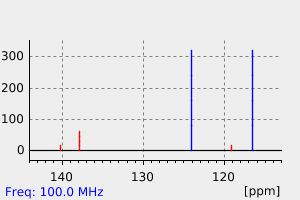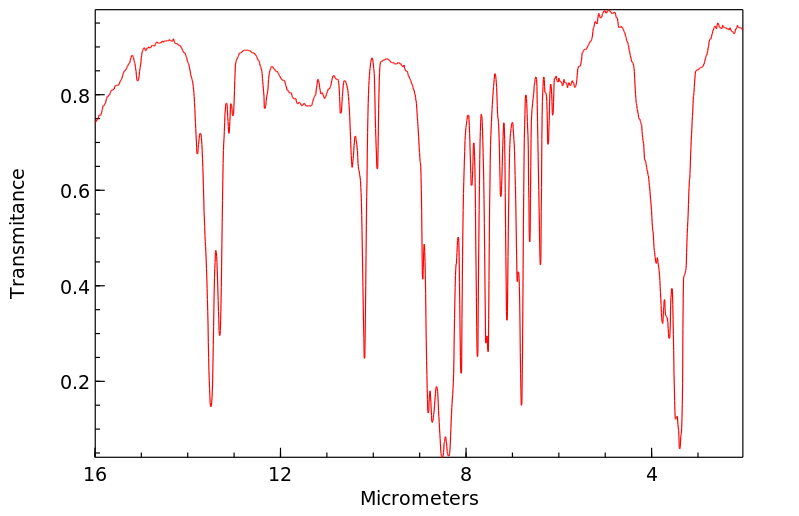2-(三氟甲基)苯并咪唑 | 312-73-2
中文名称
2-(三氟甲基)苯并咪唑
中文别名
2-(三氟甲基)-1H-苯并[D]咪唑
英文名称
2-Trifluoromethylbenzimidazole
英文别名
2-(trifluoromethyl)-1H-benzo[d]imidazole;2-(Trifluoromethyl)benzimidazole;2-(trifluoromethyl)-1H-benzimidazole
CAS
312-73-2
化学式
C8H5F3N2
mdl
MFCD00022675
分子量
186.136
InChiKey
MXFMPTXDHSDMTI-UHFFFAOYSA-N
BEILSTEIN
——
EINECS
——
-
物化性质
-
计算性质
-
ADMET
-
安全信息
-
SDS
-
制备方法与用途
-
上下游信息
-
文献信息
-
表征谱图
-
同类化合物
-
相关功能分类
-
相关结构分类
物化性质
-
熔点:208-211 °C(lit.)
-
沸点:262.8±40.0 °C(Predicted)
-
密度:1.3658 (estimate)
-
溶解度:>27.9 [ug/mL]
-
稳定性/保质期:
请避免与不相容的材料接触,并避免将其存放在高温环境中。
计算性质
-
辛醇/水分配系数(LogP):2.7
-
重原子数:13
-
可旋转键数:0
-
环数:2.0
-
sp3杂化的碳原子比例:0.125
-
拓扑面积:28.7
-
氢给体数:1
-
氢受体数:4
安全信息
-
危险等级:6.1(a)
-
危险品标志:T
-
危险类别码:R23/24/25,R36/37/38
-
危险品运输编号:UN 2811 6.1/PG 2
-
WGK Germany:3
-
RTECS号:DE1576000
-
海关编码:2933990090
-
包装等级:II
-
危险类别:6.1(a)
-
安全说明:S22,S26,S28A,S36/37/39,S45
-
危险性防范说明:P261,P305+P351+P338
-
危险性描述:H315,H319,H335
-
储存条件:密封储存,应存放在阴凉、干燥的库房中。
SDS
| Name: | 2-(Trifluoromethyl)benzimidazole Material Safety Data Sheet |
| Synonym: | 1H-Benzimidazole,2-(trifluoromethyl) |
| CAS: | 312-73-2 |
Synonym:1H-Benzimidazole,2-(trifluoromethyl)
Section 2 - COMPOSITION, INFORMATION ON INGREDIENTS
| CAS# | Chemical Name | content | EINECS# |
| 312-73-2 | 2-(Trifluoromethyl)benzimidazole | 100.0 | unlisted |
Risk Phrases: 25
Section 3 - HAZARDS IDENTIFICATION
EMERGENCY OVERVIEW
Toxic if swallowed.
Potential Health Effects
Eye:
May cause eye irritation.
Skin:
May cause skin irritation.
Ingestion:
May be fatal if swallowed. May cause irritation of the digestive tract.
Inhalation:
May cause respiratory tract irritation.
Chronic:
No information found.
Section 4 - FIRST AID MEASURES
Eyes: Flush eyes with plenty of water for at least 15 minutes, occasionally lifting the upper and lower eyelids. Get medical aid immediately.
Skin:
Get medical aid. Flush skin with plenty of water for at least 15 minutes while removing contaminated clothing and shoes. Wash clothing before reuse.
Ingestion:
If victim is conscious and alert, give 2-4 cupfuls of milk or water.
Never give anything by mouth to an unconscious person. Get medical aid.
Inhalation:
Remove from exposure and move to fresh air immediately. If not breathing, give artificial respiration. If breathing is difficult, give oxygen. Get medical aid.
Notes to Physician:
Antidote: None reported.
Section 5 - FIRE FIGHTING MEASURES
General Information:
As in any fire, wear a self-contained breathing apparatus in pressure-demand, MSHA/NIOSH (approved or equivalent), and full protective gear. During a fire, irritating and highly toxic gases may be generated by thermal decomposition or combustion.
Extinguishing Media:
Use water spray, dry chemical, carbon dioxide, or appropriate foam.
Section 6 - ACCIDENTAL RELEASE MEASURES
General Information: Use proper personal protective equipment as indicated in Section 8.
Spills/Leaks:
Clean up spills immediately, observing precautions in the Protective Equipment section. Sweep up or absorb material, then place into a suitable clean, dry, closed container for disposal. Avoid generating dusty conditions. Provide ventilation.
Section 7 - HANDLING and STORAGE
Handling:
Wash thoroughly after handling. Remove contaminated clothing and wash before reuse. Use with adequate ventilation. Minimize dust generation and accumulation. Avoid contact with eyes, skin, and clothing. Keep container tightly closed. Avoid ingestion and inhalation.
Storage:
Keep container closed when not in use. Store in a tightly closed container. Store in a cool, dry, well-ventilated area away from incompatible substances.
Section 8 - EXPOSURE CONTROLS, PERSONAL PROTECTION
Engineering Controls:
Use adequate ventilation to keep airborne concentrations low.
Exposure Limits CAS# 312-73-2: Personal Protective Equipment Eyes: Wear appropriate protective eyeglasses or chemical safety goggles as described by OSHA's eye and face protection regulations in 29 CFR 1910.133 or European Standard EN166.
Skin:
Wear appropriate protective gloves to prevent skin exposure.
Clothing:
Wear appropriate protective clothing to prevent skin exposure.
Respirators:
Follow the OSHA respirator regulations found in 29 CFR 1910.134 or European Standard EN 149. Use a NIOSH/MSHA or European Standard EN 149 approved respirator if exposure limits are exceeded or if irritation or other symptoms are experienced.
Section 9 - PHYSICAL AND CHEMICAL PROPERTIES
Physical State: Solid
Color: Not available.
Odor: None reported.
pH: Not available.
Vapor Pressure: Not available.
Viscosity: Not available.
Boiling Point: Not available.
Freezing/Melting Point: 208.00 - 211.00
Autoignition Temperature: Not applicable.
Flash Point: Not available.
Explosion Limits, lower: N/A
Explosion Limits, upper: N/A
Decomposition Temperature:
Solubility in water:
Specific Gravity/Density:
Molecular Formula: C8H5F3N2
Molecular Weight: 186.0436
Section 10 - STABILITY AND REACTIVITY
Chemical Stability:
Stable under normal temperatures and pressures.
Conditions to Avoid:
Incompatible materials, dust generation, strong oxidants.
Incompatibilities with Other Materials:
Oxidizing agents.
Hazardous Decomposition Products:
Irritating and toxic fumes and gases.
Hazardous Polymerization: Has not been reported.
Section 11 - TOXICOLOGICAL INFORMATION
RTECS#:
CAS# 312-73-2: DE1576000 LD50/LC50:
CAS# 312-73-2: Oral, rat: LD50 = 28 mg/kg.
Carcinogenicity:
2-(Trifluoromethyl)benzimidazole - Not listed by ACGIH, IARC, or NTP.
Other:
See actual entry in RTECS for complete information.
Section 12 - ECOLOGICAL INFORMATION
Other No information available.
Section 13 - DISPOSAL CONSIDERATIONS
Dispose of in a manner consistent with federal, state, and local regulations.
Section 14 - TRANSPORT INFORMATION
IATA
Shipping Name: TOXIC SOLID, ORGANIC, N.O.S.*
Hazard Class: 6.1
UN Number: 2811
Packing Group: II
IMO
Shipping Name: TOXIC SOLID, ORGANIC, N.O.S.
Hazard Class: 6.1
UN Number: 2811
Packing Group: II
RID/ADR
Shipping Name: TOXIC SOLID, ORGANIC, N.O.S.
Hazard Class: 6.1
UN Number: 2811
Packing group: II
Section 15 - REGULATORY INFORMATION
European/International Regulations
European Labeling in Accordance with EC Directives
Hazard Symbols: T
Risk Phrases:
R 25 Toxic if swallowed.
Safety Phrases:
S 28 After contact with skin, wash immediately
with...
S 28A After contact with skin, wash immediately with
plenty of water.
S 37 Wear suitable gloves.
S 45 In case of accident or if you feel unwell, seek
medical advice immediately (show the label where
possible).
WGK (Water Danger/Protection)
CAS# 312-73-2: No information available.
Canada
None of the chemicals in this product are listed on the DSL/NDSL list.
CAS# 312-73-2 is not listed on Canada's Ingredient Disclosure List.
US FEDERAL
TSCA
CAS# 312-73-2 is not listed on the TSCA inventory.
It is for research and development use only.
SECTION 16 - ADDITIONAL INFORMATION
N/A
制备方法与用途
上下游信息
-
上游原料
中文名称 英文名称 CAS号 化学式 分子量 苯并咪唑 benzoimidazole 51-17-2 C7H6N2 118.138 -
下游产品
中文名称 英文名称 CAS号 化学式 分子量 6-溴-2-(三氟甲基)-1H-苯并咪唑 6-bromo-2-(trifluoromethyl)-1H-benzo[d]imidazole 3671-60-1 C8H4BrF3N2 265.032 —— 2-trifluoridemethylimidazo-[4,5-d]-phenazine —— C14H7F3N4 288.232 —— 5,6-Dibromo-2-trifluoromethylbenzimidazole 6587-21-9 C8H3Br2F3N2 343.928 4-溴-2-(三氟甲基)-1H-苯并咪唑 4-bromo-2-trifluoromethyl-1(3)H-benzoimidazole 6587-23-1 C8H4BrF3N2 265.032 (9ci)-1-甲基-2-(三氟甲基)-1H-苯并咪唑 1-methyl-2-(trifluoromethyl)-1H-benzo[d]imidazole 384-46-3 C9H7F3N2 200.163 —— 4,7-Dibrom-2-trifluormethyl-benzimidazol 4228-97-1 C8H3Br2F3N2 343.928 1H-苯并咪唑-2-甲酸 2-benzimidazolecarboxylic acid 2849-93-6 C8H6N2O2 162.148 5-硝基-2-(三氟甲基)-1H-苯并咪唑 5-nitro-2-(trifluoromethyl)-1H-benzo[d]imidazole 327-19-5 C8H4F3N3O2 231.134 —— 4,5,6-Tribrom-2-trifluormethyl-benzimidazol 7682-32-8 C8H2Br3F3N2 422.824 —— 4,5,6,7-tetraiodo-2-trifluoromethyl-1H-benzimidazole 1196457-16-5 C8HF3I4N2 689.723 —— 4,6,7-Tribromo-2-trifluoromethyl-1H-benzoimidazole 3393-60-0 C8H2Br3F3N2 422.824 - 1
- 2
反应信息
-
作为反应物:描述:参考文献:名称:2-三氟甲基咪唑,2,4,5-三(三氟甲基)咪唑及相关化合物摘要:由咪唑-2-羧酸与四氟化硫反应制得的2-三氟甲基咪唑,得到的银盐与有机卤化物(溴甲烷,溴乙酸乙酯,N,N-二甲基-2-氯乙胺和氯乙腈)反应,得到相应的N-烷基化的衍生物。通过氧化2-三氟甲基苯并咪唑而获得2-三氟甲基咪唑-4,5-二羧酸,并且在脱羧时仅得到痕量的2-三氟甲基咪唑。主要产物为2-三氟甲基咪唑-4-羧酸。二酸和四氟化硫得到2,4,5-三(三氟甲基)咪唑。DOI:10.1016/s0022-1139(00)85263-x
-
作为产物:描述:2,2,2-trifluoro-N-(2-nitrophenyl)acetamide 在 palladium on activated charcoal 氢气 作用下, 以 乙醇 为溶剂, 120.0 ℃ 、896.31 kPa 条件下, 反应 18.0h, 以88%的产率得到2-(三氟甲基)苯并咪唑参考文献:名称:由脱氢松香酸短合成苯并[2,3- d ]咪唑。该方法的应用作为苯并咪唑的便捷途径摘要:通过与“ claycop”(一种浸有硝酸铜(II)的蒙脱土)反应,在12位选择性地将顺式-异异丙基脱氢松香酸甲酯硝化。将12-硝基化合物还原为相应的胺,并将其进行酰化和邻硝化的组合。通过还原环化将如此产生的化合物进一步转化为八氢-1 H-菲并[2,3- d ]咪唑。结果表明,相同的酰化-邻硝化方法可从苯胺短时间合成2-取代的苯并咪唑。DOI:10.1016/s0040-4020(00)01158-3
文献信息
-
Aromatic amine derivative and use thereof申请人:Taniguchi Takahiko公开号:US20090325956A1公开(公告)日:2009-12-31The present invention provides a novel SCD inhibitor. An SCD inhibitor containing a compound represented by the formula [I] wherein ring A is an optionally substituted aromatic ring, ring B is an optionally substituted ring, ring C is an optionally substituted aromatic ring, R is a hydrogen atom, an optionally substituted hydrocarbon group or an optionally substituted heterocyclic group, and X is a spacer having 1 to 5 atoms in the main chain, or a salt thereof, or a prodrug thereof.
-
Synthesis of Novel Halogenated Heterocycles Based on o-Phenylenediamine and Their Interactions with the Catalytic Subunit of Protein Kinase CK2作者:Maria Winiewska-Szajewska、Agnieszka Monika Maciejewska、Elżbieta Speina、Jarosław Poznański、Daniel PaprockiDOI:10.3390/molecules26113163日期:——Protein kinase CK2 is a highly pleiotropic protein kinase capable of phosphorylating hundreds of protein substrates. It is involved in numerous cellular functions, including cell viability, apoptosis, cell proliferation and survival, angiogenesis, or ER-stress response. As CK2 activity is found perturbed in many pathological states, including cancers, it becomes an attractive target for the pharma蛋白激酶CK2是高度多效性蛋白激酶,能够磷酸化数百种蛋白底物。它涉及许多细胞功能,包括细胞活力,凋亡,细胞增殖和存活,血管生成或ER应激反应。由于发现CK2活性在包括癌症在内的许多病理状态中受到干扰,因此它成为该药的有吸引力的靶标。已经开发了许多低质量的ATP竞争性抑制剂,其中大多数已被卤化。我们测试了六种系列卤代杂环配体的结合,这些配体衍生自可商购的4,5-二卤代苯-1,2-二胺。选择这些配体系列以使支架作用与直接归因于卤素原子存在的疏水相互作用分离。最初使用计算机分子对接技术来测试每种配体在CK2的ATP结合位点结合的能力。将HPLC衍生的配体疏水性数据与通过小体积差示扫描荧光法(nanoDSF)评估的结合亲和力进行比较。我们确定了三个有希望的配体支架,其中两个尚未被描述为CK2抑制剂,但可能导致有效的CK2激酶抑制剂。已经确定了在nanoDSF分析中被鉴定为最有前途的八种化合物对CK
-
FLUOROALKYLATING AGENT申请人:IHARA CHEMICAL INDUSTRY CO., LTD.公开号:US20170197920A1公开(公告)日:2017-07-13Problem to be Solved It is intended to provide an industrially preferable fluoroalkylating agent and use thereof. Solution The present invention provides a fluoroalkylating agent represented by the general formula (1) wherein R 1 is a C1 to C8 fluoroalkyl group; R 2 and R 3 are each independently a C1 to C12 alkyl group or the like; Y 1 to Y 4 are each independently a hydrogen atom, a halogen atom, or the like; and X − is a monovalent anion. A compound of the general formula (3): R 4 —S—R 1 having an introduced C1 to C8 fluoroalkyl group is easily obtained by reacting a compound of the general formula (2): R 4 —S—Z wherein R 4 is a hydrocarbon group or the like; and Z is a leaving group, with the compound of the general formula (1).要解决的问题 旨在提供一种工业上可取的氟烷基化剂及其使用方法。 解决方案 本发明提供了一种由通式(1)表示的氟烷基化剂,其中R 1 是C1到C8的氟烷基团;R 2 和R 3 分别独立地是C1到C12的烷基团或类似物;Y 1 到Y 4 分别独立地是氢原子、卤素原子或类似物;X − 是一价阴离子。 通式(3)的化合物:R 4 —S—R 1 ,其中引入了C1到C8的氟烷基团,可通过将通式(2)的化合物:R 4 —S—Z(其中R 4 是烃基团或类似物;Z是离去基团)与通式(1)的化合物反应而轻松获得。
-
[EN] BENZIMIDAZOLE DERIVATIVES AND THEIR USE AS VANILLOID RECEPTOR LIGANDS<br/>[FR] DERIVES DE BENZIMIDAZOLES ET UTILISATION DE CEUX-CI EN TANT QUE LIGANDS DU RECEPTEUR VANILLOIDE申请人:AMGEN INC公开号:WO2004035549A1公开(公告)日:2004-04-29Compounds of formula (I) are useful in the treatment of vanilloid-receptor-meditated diseases, such as inflammatory or neuropathic pain and diseases involving sensory nerve function such as asthma, rheumatoid arthritis, osteoarthritis, inflammatory bowel disorders, urinary incontinence, migraine and psoriasis.式(I)的化合物在治疗辣椒素受体介导的疾病方面很有用,如炎症性或神经病痛以及涉及感觉神经功能的疾病,如哮喘、类风湿性关节炎、骨关节炎、炎症性肠道疾病、尿失禁、偏头痛和牛皮癣。
-
Design, synthesis and biological evaluation of 3′,4′,5′-trimethoxy flavonoid benzimidazole derivatives as potential anti-tumor agents作者:Zhe Wang、Xiangping Deng、Runde Xiong、Shujuan Xiong、Juan Liu、Xuan Cao、Xiaoyong Lei、Yanming Chen、Xing Zheng、Guotao TangDOI:10.1039/c7md00578d日期:——A series of 3′,4′,5′-trimethoxy flavonoids with benzimidazole linked by different chain alkanes have been designed and synthesized. The potential activity of these compounds as anti-tumor agents was evaluated by cytotoxicity assay in MGC-803 (human gastric cancer), MCF-7 (human breast cancer), HepG-2 (human hepatoma) and MFC (mouse gastric cancer) tumor cell lines. Among them, compound 15 7-(3-(2-设计并合成了一系列苯并咪唑通过不同链烷烃连接的3',4',5'-三甲氧基黄酮类化合物。这些化合物作为抗肿瘤药的潜在活性通过MGC-803(人类胃癌),MCF-7(人类乳腺癌),HepG-2(人类肝癌)和MFC(小鼠胃癌)肿瘤中的细胞毒性试验进行了评估。细胞系。其中,化合物15 7-(3-(2-氯-1 H-苯并[ d ]咪唑-1-基)丙氧基)-2-(3,4,5-三甲氧基苯基)-4 H-铬烯-4-一种显示最有效的抗增殖活性,IC 50值分别为20.47±2.07、43.42±3.56、35.45±2.03μM和23.47±3.59μM。流式细胞仪(FCM)结果表明化合物15导致细胞周期停滞在G1期,并以剂量依赖性方式诱导MFC细胞凋亡。另外,化合物15对体内肿瘤生长显示出显着的抑制作用。所有结果概述了化合物15作为抗肿瘤剂的进一步开发的巨大潜力。
表征谱图
-
氢谱1HNMR
-
质谱MS
-
碳谱13CNMR
-
红外IR
-
拉曼Raman
-
峰位数据
-
峰位匹配
-
表征信息
同类化合物
(S)-(-)-2-(α-(叔丁基)甲胺)-1H-苯并咪唑
(S)-(-)-2-(α-甲基甲胺)-1H-苯并咪唑
麦穗宁
马哌斯汀
颜料橙62
顺式-5,6-二氢-4,5-二甲基-4H-咪唑并[1,5,4-De]喹喔啉
韦罗肟
青菌灵
雷贝拉唑钠
雷贝拉唑硫醚N-氧化物
雷贝拉唑砜 N-氧化物
雷贝拉唑砜
雷贝拉唑杂质2
雷贝拉唑 N-氧化物
雷贝拉唑
阿苯达唑砜
阿苯达唑杂质L
阿苯达唑杂质J(EP)
阿苯达唑杂质J
阿苯达唑杂质F
阿苯达唑杂质14
阿苯达唑杂质13
阿苯达唑亚砜
阿苯达唑
阿苯哒唑砜-D3
阿苯哒唑-D3
阿地本旦
阿司咪唑-d3
阿司咪唑
钠4-[5-氯-2-[(E,3E)-3-[6-氯-1-乙基-3-(4-磺酸丁基)-5-(三氟甲基)苯并咪唑-2-亚基]丙-1-烯基]-3-乙基-6-(三氟甲基)苯并咪唑-1-鎓-1-基]丁烷-1-磺酸盐
邻甲磺酰胺基苯乙酸
那地特罗
达比加群酯杂质M
达比加群酯杂质4
达比加群酯杂质1
达比加群酯杂质
达比加群酯N-氧化物
达比加群酯
达比加群脂杂质10
达比加群甲酯杂质
达比加群杂质J
达比加群杂质J
达比加群杂质F
达比加群杂质E
达比加群杂质D
达比加群杂质C5
达比加群杂质38
达比加群杂质13
达比加群杂质10(DABRC-10)
达比加群杂质10








